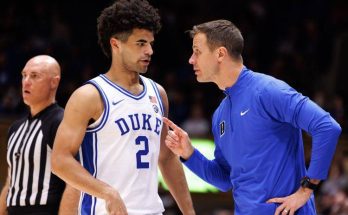Indiana Basketball’s 2025–26 Non-Conference Preview: Rivals, Resets, and a Roadmap to March
With new leadership on the sidelines and a blend of experienced returners, high-upside transfers, and young talent, Indiana men’s basketball enters the 2025–26 season at a pivotal crossroads. After a decade of inconsistent postseason results and coaching turnover, the program has placed its faith in Darian DeVries, the meticulous and defensive-minded coach known for orchestrating turnarounds at Drake and, most recently, West Virginia.
This year’s non-conference schedule sets the stage—not just for wins and losses, but for identity formation. It’s a thoughtfully balanced slate, featuring high-major titans like Kentucky, Louisville, and Marquette, as well as strategic mid-majors designed to sharpen Indiana’s rotation and team chemistry before the brutal Big Ten gauntlet.
Let’s break down the schedule in detail, analyze the opposition, and project what it means for Indiana’s outlook heading into DeVries’ first season.
The crown jewel of this year’s non-conference slate. Indiana and Kentucky renew one of college basketball’s most storied rivalries with a high-stakes clash at Rupp Arena. For the first time since 2011, the Hoosiers will travel to Lexington in what promises to be a firecracker atmosphere.
Under second-year head coach Mark Pope, Kentucky is loaded. Sophomore wing Otega Oweh, a high-level scorer and defender, leads a balanced group that blends former five-stars with mature transfers. Pope, a former Wildcat himself, has emphasized tough defense and efficient transition scoring—two things Indiana must counter effectively.
For DeVries, it’s not just a test of coaching acumen—it’s an early referendum on Indiana’s ability to win on the road against elite competition. A victory at Rupp would instantly thrust the Hoosiers into national relevance.
Key Questions:
- Can IU’s guards handle UK’s pressure?
- Will Tucker DeVries (coach’s son) rise to the challenge in a hostile environment?
- How will the frontcourt respond to UK’s athleticism?
A fierce in-state rivalry with echoes of regional bragging rights, this matchup at Gainbridge Fieldhouse (Indianapolis) is a battle of resurgent programs. Louisville, under Pat Kelsey, is coming off a breakthrough 27-win season and returns several key shooters, including point guard Ty-Laur Johnson and sharp-shooting forward Trenton Flowers.
Kelsey plays fast, aggressive basketball—a far cry from Indiana’s more measured, half-court preferences. The clash of tempos will define this one.
More than just a résumé-building opportunity, it’s also a litmus test for IU’s ability to play at pace and defend the perimeter. Louisville ranked among the top 10 in the country in three-point rate last year.
What’s at Stake:
- Indiana fans have flooded Indy for decades—expect Assembly Hall South.
- Neutral-site wins are gold for NCAA résumé strength.
- A loss wouldn’t be devastating—but a win would solidify IU’s tournament credentials.
A high-octane showdown between Big Ten and Big East heavyweights, this early-season battle headlines Indiana’s involvement in a multi-team event. Marquette, led by dynamic coach Shaka Smart, is expected to be a top-10 team again, fueled by their relentless pressure defense and unselfish ball movement.
Shaka’s team is known for full-court pressure, live-ball turnovers, and chaos creation. Indiana’s ball security and transition defense will be under a microscope.
For Coach DeVries, it’s a critical early data point: Can his system stand tall against an elite opponent that plays a radically different style?
Storylines to Watch:
- Indiana freshman Malik Thompson could be the key X-factor off the bench.
- Will DeVries adjust his slower-paced preferences to match tempo?
- Chicago-based Hoosier fans are expected to flood the United Center.
A sneaky-tough test at Assembly Hall. Kansas State has been consistently competitive under Jerome Tang, who’s led the Wildcats to back-to-back tournament appearances. The team boasts an elite backcourt duo in Cam Carter and sophomore breakout guard Jamarion Sharp Jr.
IU has home-court advantage, but this is a true Quad 2 opportunity that will matter come March.
Expect a gritty, low-possession game with a premium on execution. DeVries’s defensive mindset may prove vital here.
Though they won’t grab national headlines, Indiana’s mid-major opponents are strategically placed for development and system-building
Coached by Bart Lundy, Milwaukee plays a five-out style that tests perimeter defense and rebounding discipline. They’ve been near the top of the Horizon League and are no pushover.
Expect IU to struggle early if they don’t guard the arc effectively.
The season finale before Big Ten play begins. Siena is a well-coached team from the MAAC and features a disciplined, slow-tempo attack. It’s also a sentimental matchup—Coach DeVries’s son, Tucker, played under him at Drake, and this could be a “family circle” kind of sendoff before the holidays.
It also offers the staff a final chance to tighten rotations.
These lower-tier opponents provide the necessary “rhythm games” that allow younger players and reserves to develop. Expect to see expanded lineups, zone looks, and pressing experimentation in these contests.
Still, these games matter. Poor showings can sink a NET rating—and under the new NCAA tournament seeding model, every performance counts.
Darian DeVries takes over after a chaotic period that saw Indiana slide from annual contender to bubble team. Known for defensive toughness, pace control, and disciplined ball movement, DeVries’s approach is rooted in cohesion over chaos.
Key System Shifts to Watch:
- Ball Movement > Isolation: Expect more side-to-side action, fewer hero-ball possessions.
- Half-Court Defense: West Virginia under DeVries last season was top-25 in points allowed per possession.
- Slow Tempo: Don’t expect IU to run often—unless forced.
Early Schedule Benefits:
- Allows controlled implementation of the new system.
- Builds team identity before Big Ten play.
- Marquee opponents simulate tournament settings.
Every non-conference game plays a role in NCAA tournament evaluation—especially now that NET rankings and predictive analytics weigh performance margin, venue, and opponent quality.
A 9–2 or 10–1 non-conference record with at least two wins in Quads 1–2 would place Indiana in a great position entering Big Ten play
- Coach’s son and elite shooter
- Leader in defensive IQ and floor spacing
- Could lead IU in scoring early
- Top-50 recruit from Georgia
- Will need to learn quickly against Marquette and Kentucky
**Tyrese Hunter
(Transfer, PG)**
- Former Texas starter brings speed and experience
- His ability to manage tempo will make or break Marquette and Louisville games
Assuming Indiana stays healthy and the DeVries system takes hold:
- Predicted Record: 9–2
- Wins over Kansas State, Louisville, and Milwaukee
- Losses to Marquette and Kentucky
- NCAA Tournament Outlook:
- Strong résumé positioning heading into conference play
- Could enter January as a top-25 team with upside
The 2025–26 non-conference schedule does exactly what it’s supposed to: challenge, calibrate, and compel. Indiana will face nationally-ranked teams, rekindle century-old rivalries, and welcome underdogs hungry for an upset.
It’s a road map for not only measuring wins—but also measuring whether Darian DeVries can return IU to the place its fans believe it belongs.
This is not just a schedule. It’s a proving ground. And for Indiana, it’s time to prove again.


